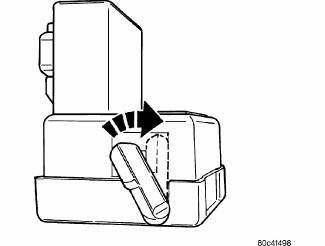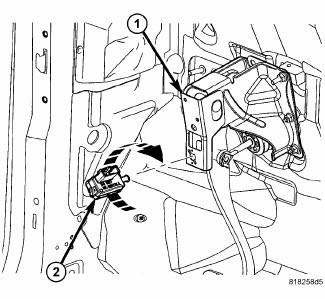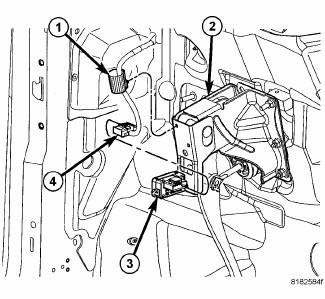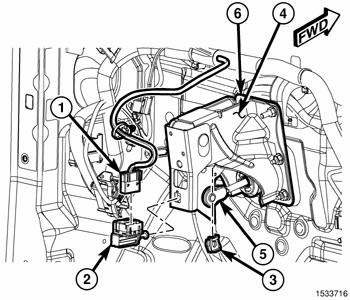Dodge Journey: Installation
Two unique brake lamp switches are used in this vehicle, depending upon whether the vehicle was built during early or late production. These switches are not interchangeable. Both switches are illustrated and described elsewhere in this service information to assist in positive identification.
WARNING: To avoid serious or fatal injury on vehicles equipped with airbags, disable the Supplemental Restraint System (SRS) before attempting any steering wheel, steering column, airbag, seat belt tensioner, impact sensor, or instrument panel component diagnosis or service. Disconnect and isolate the battery negative (ground) cable, then wait two minutes for the system capacitor to discharge before performing further diagnosis or service.
This is the only sure way to disable the SRS. Failure to take the proper precautions could result in accidental airbag deployment.
EARLY PRODUCTION
CAUTION: The brake lamp switch self-adjusting switch plunger is a one time only feature. If the switch is removed from the mounting bracket, it MUST be replaced with a new switch.

Fig. 65: Switch Adjustment Lever
1. Obtain a new brake lamp switch. The adjustment lever on the new switch should be at about a 45 degree angle to the switch connector receptacle. If the adjustment lever is parallel with the connector receptacle, the switch adjustment has already been set and the switch must be scrapped. DO NOT ATTEMPT TO RESET OR READJUST THE BRAKE LAMP SWITCH.

Fig. 66: Identifying Stop Lamp Switch & Pedal Clip
2. Depress and hold the brake pedal in the depressed position.
3. Align the tabs on the brake lamp switch (2) locking collar with the keyed hole in the brake pedal support bracket (1) below the instrument panel.
4. Insert the tabs on the brake lamp switch locking collar through the keyed hole in the brake pedal support bracket until the switch housing is firmly seated against the bracket.
5. Rotate the switch housing clockwise about 30 degrees to engage the tabs on the locking collar with the bracket.
CAUTION: Release, but do not pull up on the brake pedal before the switch plunger adjustment has been completed.
6. Release the brake pedal, but do not pull it upward.
7. Rotate the plunger adjustment release lever (2) clockwise until it locks into place. The lever should be parallel to the brake lamp switch connector receptacle. This action will set the switch plunger length to a final adjustment position and cannot be undone. If not performed properly the first time, a new brake lamp switch MUST be installed.

Fig. 67: Stop Lamp Switch Wiring Routing Clip, Brake Pedal Bracket, Stop Lamp
Switch &
Wiring Connector
8. Reconnect the wire harness connector (4) to the brake lamp switch (3).
9. If equipped, reinstall the silencer pad below the steering column.
10. Reconnect the battery negative cable.
LATE PRODUCTION

Fig. 68: Brake Lamp Switch On Brake Pedal Support Bracket
1. Be certain that the brake lamp switch (2) plunger is pulled all the way out of the switch housing to its fully extended position.
2. Reconnect the wire harness connector (1) to the connector receptacle on the switch.
3. Depress and hold the brake pedal in the depressed position.
4. Align the tabs on the brake lamp switch locking collar with the keyed hole in the brake pedal support bracket (2).
5. Insert the tab on the brake lamp switch locking collar through the keyed hole in the support bracket until the switch housing is firmly seated against the bracket.
6. Rotate the switch housing clockwise about 30 degrees to engage the tabs on the locking collar with the support bracket.
CAUTION: Brake booster damage may occur if the brake pedal pull exceeds about 9 kilograms (20 pounds).
7. Release the brake pedal. Then pull the pedal lightly upward to its normal at-rest position. The pedal will set the plunger to the correct position as the pedal pushes the plunger into the switch housing. The switch plunger will make a light audible ratcheting noise as it self-adjusts.
8. If equipped, reinstall the silencer pad below the steering column.
9. Reconnect the battery negative cable.
 Removal
Removal
Two unique brake lamp switches are used in this vehicle, depending upon
whether the vehicle was built during
early or late production. These switches are not interchangeable. Both switches
are il ...
 Adjustments
Adjustments
ADJUSTMENT - LATE PRODUCTION TYPE ONLY
Two unique brake lamp switches are used in this vehicle, depending upon
whether the vehicle was built during
early or late production. These switches are not ...
See also:
Installation
HOUSING-AIR DISTRIBUTION
NOTE: LHD model shown in illustrations. RHD model similar.
Fig. 131: Air Distribution Housing-Removal/Installation
1. Position the air distribution housing (2) onto ...
Installation
2.7L ENGINE
Fig. 32: Maniverter To Cross Under Fasteners
1. Install the cross under pipe (3). and the front maniverter-to-cross under
fasteners (1) and (2). Tighten to
27 Nm (20 ft. lb.).
Fi ...
Removal
1. Raise and support the vehicle.
2. If equipped, remove the engine belly pan.
3. Remove the rear engine mount.
4. Remove the front engine mount through-bolt.
Fig. 66: Stabilizer Link Mo ...
